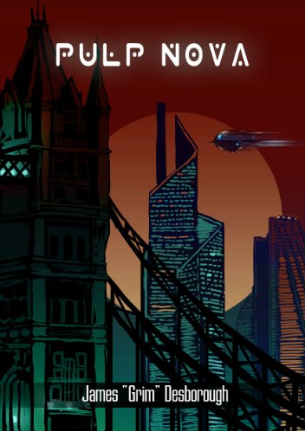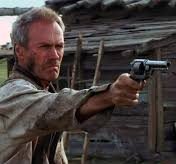 James Desborough continues his march through the genres featured in the pulps with this western tale. The general plot is a classic so prevalent that it even makes an appearance in Toy Story: “Somebody poisoned the water hole!” (That’s not a bad thing, the poisoned water hole is one of those themes that affords countless variations.) Of course it’s a no-good bunch of cattle barons trying to chase off the townsfolk so they can control the water rights and the grazing land. Again, clichés become clichés because they work, and the plot of this story just plain works. The set-up is solid, the action solid, and the prose up to Desborough’s usual standard.
James Desborough continues his march through the genres featured in the pulps with this western tale. The general plot is a classic so prevalent that it even makes an appearance in Toy Story: “Somebody poisoned the water hole!” (That’s not a bad thing, the poisoned water hole is one of those themes that affords countless variations.) Of course it’s a no-good bunch of cattle barons trying to chase off the townsfolk so they can control the water rights and the grazing land. Again, clichés become clichés because they work, and the plot of this story just plain works. The set-up is solid, the action solid, and the prose up to Desborough’s usual standard.
The hero, Mr. Shanks, is one of those charming characters, the prim and proper Brit in the west. He gunfights with a pair of Webley revolvers, wears a bowler instead of a Stetson, and walks everywhere due to a strong distaste for horses. Although quick with a gun and good with his fists, he is also a clever sort of hero who wears his well-tailored Savile Row suit as a sort of camouflage that allows him the element of surprise in most of his encounters with the unwashed and uncouth Yankee cowboys that he crosses paths with. The result is an odd sort of tale that clearly demonstrates a British perspective on the wild west, and as such, reads very different from those written by the masters of the genre like Louis Lamour, Jack Shaefer, and Peter Grant.
Desborough matches those three authors in his focus on an honorable man dispensing justice and protecting the weak, but he utterly fails at capturing the mood of the pulp westerns. His setting is dry, uncouth, and thoroughly unpleasant. It dwells on the seedy backbiters and thieving outlaws, with the sole supporting cast member presented with any sympathy at all the withered old saloon whore. Everyone needs a bath and a shave and everyone needs their mouth washed out with soap. The hero displays a mean streak a mile long, dispensing justice with a viciousness and cruelty that Lamour rarely utilized for even his worst villains.

Dirty Cowboys in 1992
You may object that Desborough’s aim with Pulp Nova was not to mimic the pulps, but to bring them forward to a more modern understanding. He certainly does that with Shank’s Bulldog, bringing the western a few decades forward to smack dab in the middle of the deconstruction era where all of the polish and heroism was removed in favor of a more “realistic” (read: judgemental) attitude toward that period of history. To that end, he abandons his premise and, like so many of the new pulp crowd, engages in a cargo cultism. With colorful characters and fast action and the obligatory quick draw showdown, he has the trappings correct, but he shows no real understanding of what made the pulp stories resonate with readers. As a result, the reader is left with a grubby little story about the only man who showers in the west torturing the bad guys to death. There’s no heart, no heroism, and no inspiration here.
In the end, this story winds up being a data point in favor of Daddy Warpig’s thesis that every attempt to improve the pulps has been an attempt at addition by subtraction. Desborough’s update removes the heroism and the inspiration, and while that can make for a fine modern story that revels in nihilism, it is fundamentally incompatible with the pulps. More than that, it’s fundamentally incompatible with presenting a timeless tale sure to be enjoyed eighty years later.
It’s a noble attempt, but it’s the second story in a row where Desborough updates a pulp by making in thoroughly post-modern in outlook. That’s not an upgrade. It’s not new, and it’s not different. People have been doing this to westerns for forty years. It’s clear that Desborough’s strength lies in grim stories. (That should come as no surprise as his nickname, “Grim”, is listed right there on the cover.) His temperament is better suited to the weird tales and existential horror, he excels at those stories, but not to the daring tales of frontier justice.
I presume you might mean Peter Grant, rather than Patrick Grant? The only Patrick Grant I could find is a British fashion designer, not an author of Westerns.
-
As a matter of fact I did. A CH author, no less. I am ashamed.
I kinda figured Dewsborough would go this route after checking out his youtube channel. He’s fairly well — though not completely — bought-in to the current narrative. It’s too bad since, as an Englishman, he could’ve done some good things with his unorthodox — but not ahistorical — protagonist.
I’m willing to bet that the rest of the collection reads much closer to “New Pulp” guys like Wendig and Lansdale than it does Correia or Wright.
-
Lansdale can still produce a decent pulpish yarn every now and then, when he’s not busy virtue signaling. His “Crawling Sky” might make for a good comparison with this story, as it is definitely steeped in dirt and grit but still features proper hero and heroism. I’ve got slight flashes of Wellman’s pulp heroes from that one.
-
I met and hung out with JRL in Cross Plains a few years ago. He definitely comes from the left side of the aisle and is very proud of it. I’ve enjoyed some of his work, but he takes glee in trashing tropes and doing “crazy” for the sake of crazy. You could call him the “Texan Moorcock”, an author he admires.